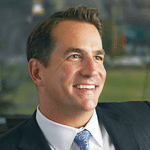 David Kohler
David Kohler
Kohler Co.
“It’s okay to be a capitalist and an industrialist and an environmentalist at the same time,” says David Kohler, president of the fixture manufacturer Kohler Co. Kohler, the fourth generation of executives since the company’s founding in 1873, is committed to environmental stewardship. In 2008 this evolved into a sustainability program with three pillars—reducing the company’s footprint, creating sustainable products, and focusing on communication and education—and has led to gains such as a three percent annual reduction in greenhouse gas emissions and the creation of more than 300 products with the EPA’s WaterSense label. Kohler is uninterested in compromise, introducing projects that aim to be mutually beneficial to consumers, business partners, and of course the environment. His leadership shows that what’s right for big business can also be right for the environment. Read the full story.
 Doug Widener
Doug Widener
USGBC
All it needs is a gentle shove, says Doug Widener, the USGBC’s director of community advancement, who believes the industry is at its tipping point. Widener’s three-year plan to strengthen the USGBC by creating cohesion between its 77 national and state chapters is meant to advance green building past its previous potential. Widener, a nonprofit industry veteran, brought an important non-builder viewpoint to the organization when he became the executive director of USGBC Chicago in 2006. During his tenure, Widener consolidated USGBC’s Illinois chapters into a single entity—creating USGBC Illinois, the largest USGBC chapter by membership. By connecting the chapters and facilitating communication, Widener hopes to find innovative methods for connecting professionals and people and then replicate and improve those strategies to tap into this young industry’s infinite possibilities. Read the full story.
 Glenn Heinmiller
Glenn Heinmiller
Lam Partners
As a principal at Lam Partners, Glenn Heinmiller’s role is to reveal the work of others. While working on the US Institute of Peace in Washington, DC, Heinmiller’s architectural lighting design concentrated on understanding architect Moshe Safdie’s vision and exposing facets of the building that were unique, such as the structure’s translucent roof. Heinmiller is always striving to make lighting design a larger part of the discussion when planning a building because he says lighting is most successful when designers are seamlessly integrated into the design team from the beginning. He’s also looking for energy efficiency whenever possible, such as in the Kauffman Center in Kansas City. Instead of handcuffing himself to halogen lighting, one of the least efficient lighting sources, Heinmiller squeezed maximum energy efficiency out of its system through a complex, infrared-driven, dimming scheme. What he creates is subtlety and nuance—he’s a luminary in the shadows. Read the full story.
 Kevin Daniels
Kevin Daniels
Daniels Real Estate
“Sustainability begins with preservation,” is the motto of Daniels Real Estate and its founder Kevin Daniels, who also sits on the board for the National Trust for Historic Preservation. Daniels is behind Seattle’s largest transit-oriented development, the LEED Gold Stadium Place, which will create 1.5 million square feet of new space in Seattle’s historic Pioneer Square neighborhood. Although the construction is new, the development is all about reviving and preserving an old area of the city. Daniels mimicked the existing Romanesque-style brick and timber structures with buildings that used natural materials and were the same height as the historic ones and set new high-rises back from the street so that pedestrians would still have an “old city” feel while it looked modern from above. But Daniels also wanted to add to Seattle’s history by introducing iconic contemporary architecture to the area, hence the project’s South Tower, a funky, boxy, modern 26-story building that will soon grace the Seattle skyline. Read the full story.
 Rita Benson LeBlanc
Rita Benson LeBlanc
New Orleans Saints
Rita Benson LeBlanc has a yearly tradition. She rappels down the 400-foot-tall, LEED-certified Benson Tower, which is the first LEED high-rise commercial office tower in New Orleans, in a fundraising stunt for the Special Olympics fundraising stunt. As the vice-chairperson of the New Orleans Saints and New Orleans Pelicans, LeBlanc is invested in New Orleans, its future, and its citizens, which is why her family sustainably revitalized the Benson Tower. In the aftermath of Hurricane Katrina, the Bensons struck a deal with the State of Louisiana to renovate what was formerly Dominion Tower and retrofit it with new air-distribution systems, new lighting, and state-of-the-art MEP systems. Along with Champions Square, an open-air venue capable of hosting 8,000 guests for pregame festivities or concerts (the Mercedes-Benz Superdome is next door), the tower is a symbol of a revitalized downtown New Orleans, moving the city toward a greener future. Read the full story.

